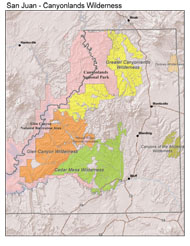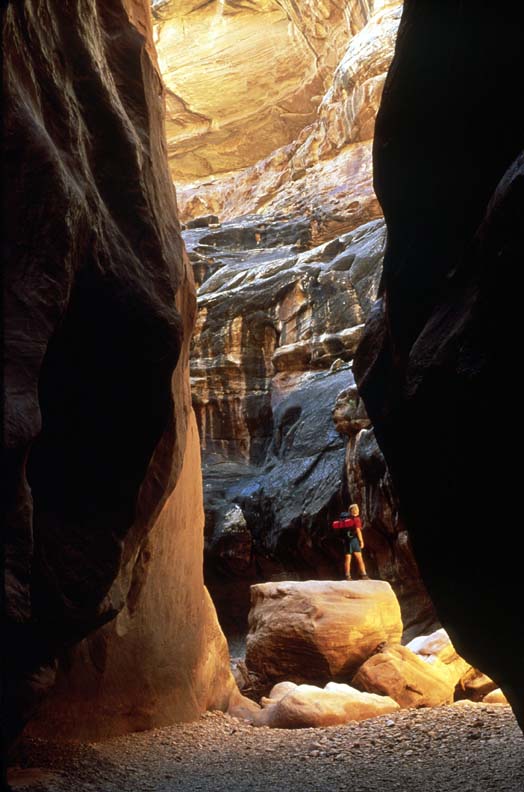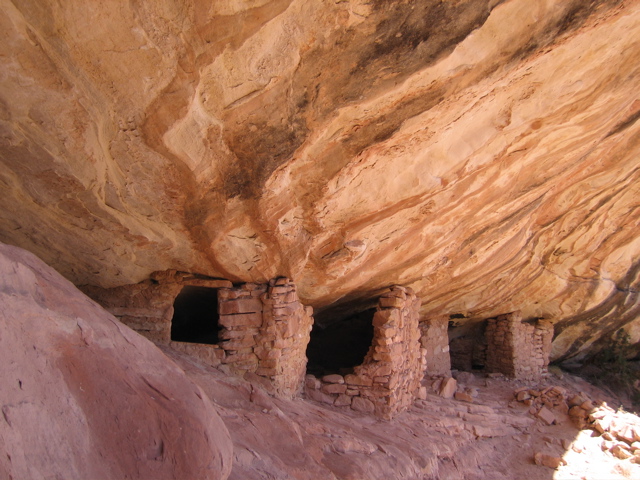|
The San Juan-Canyonlands Proposed Wilderness
Latest Update: Great news! We’ve learned recently that Senator Bob Bennett (R-UT) is not
likely to try pushing a harmful bill for the San Juan-Canyonlands landscape. Thanks to all
of you who contacted your members of Congress on this important issue!
Earlier this summer we asked you to alert your members of Congress that an
inadequate bill for these magnificent lands could be in the works, and any bill
that ratified the Bush policies for the San Juan-Canyonlands wilderness would be
unacceptable. After spending the August congressional recess investigating
whether and how a bill could move, we believe it is unlikely that a San
Juan-Canyonlands bill will be introduced this year.
And thanks go to you, the redrock activists from California to Maine, who
contacted your members of Congress and helped educate them on the
importance of protecting all of the wild lands in the San Juan-Canyonlands
region.
Even though a San Juan-Canyonlands bill is not likely this year, immediate protection can still be gained for the
deserving wilderness lands there, and throughout Utah. All it would take is the
Obama administration rescinding the “No More Wilderness” policy and fixing the Bush Plans that now dictate management of
public lands in Utah.
Take Action: Please tell President Obama to protect wild Utah
now!
About the San Juan-Canyonlands Region: The San Juan-Canyonlands region of Southeastern Utah is one of the most iconic landscapes recommended for protection in America’s Red Rock Wilderness Act, boasting dramatic geologic features wrought by elemental forces, as well as internationally significant cultural sites of the Ancestral Puebloans and the Mormon Pioneers. Adorned with buttes and arches, vast stretches of slickrock deposited over 250 million years ago, ancient pinyon-juniper forests and an artist’s pallet of red-hued sandstone, the San Juan-Canyonlands region has inspired explorers since the days of John Wesley Powell, and its wonders represent some of the greatest unprotected wilderness in the country.
Nearly 3,000 years ago this country was occupied by Ancestral Puebloans, and abundant traces of that culture still exist in canyons and on mesa tops throughout. So numerous are the kivas, cliff dwellings, storage granaries, rock art, and tool-making sites in this region that the BLM estimated there could be as many as 11,000 unrecorded sites in Grand Gulch alone.
Rugged Mormon pioneers would later cross this country in horse-drawn wagons, sometimes scraping trails through fortresses of rock and using natural landmarks to guide their travels to their frontier settlements. Now, this vast expanse of sandstone, serpentine canyons and high mesas has become the destination, not the obstacle, and is one of the most popular areas in Utah for recreational use.
But lands with important cultural sites like Arch Canyon, Moqui Canyon, White Canyon, Monument Canyon and the benches along the San Juan River are threatened by growing off-road vehicle (ORV) use. ORV access increases the risk of unintentional damage, intentional vandalism, and looting of the artifacts left behind by prehistoric cultures. ORV use also damages streambeds, impairs fish habitat, and increases soil and dust erosion.
The San Juan-Canyonlands region can best be understood as five discrete regions: the Cedar Mesa Wilderness, the Glen Canyon Wilderness, the Greater Canyonlands Wilderness, the Hovenweep Wilderness, and the Dolores River Wilderness.
The Cedar Mesa Wilderness is bordered on the east by the 90-mile bristle of Comb Ridge, which forms an imposing 600-foot tall natural barrier that provides ample habitat for birds of prey, is a repository of ancient rock art, and is the bookend for the rugged lands west of its spine. Those lands include places like Valley of the Gods, Fish and Owl Creek Canyons, Lime Creek, The Tabernacle, and Grand Gulch. The southern border of this area is cradled by the meanderings of the San Juan River.
To the west and north is the Glen Canyon Wilderness, where the vast expanse of Paleozoic-era sandstone known as Nokai Dome eases its way to the upper reaches of Lake Powell in the Glen Canyon National Recreation Area. This region also includes the soaring Wingate Cliffs of the Red Rock Plateau, Mancos Mesa, Moqui Canyon with its meandering stream, Red Canyon, and the serpentine side canyons of White Canyon. The expanses of pinyon and juniper forest studded with mesas and buttes are pristine high desert treasures, providing habitat for herds of elusive desert bighorn sheep. In the rare desert riparian areas here, one can relax in a cool haven of cottonwoods and willows, just as the Ancestral Puebloans did centuries ago. This is one of the most remote regions of the state, but it lacks protection and is threatened by increasing ORV use.
In the proposed Greater Canyonlands Wilderness, adjacent to the current Canyonlands National Park, some of the wildest canyons in the state wind through the crags of the oldest geologic rock layers exposed in southern Utah. Part of Dark Canyon already enjoys wilderness protection, but arbitrary federal boundaries have left equally-wild areas exposed to threats. This canyon system serves as refuge for the desert bighorn and as a greenhouse for cacti and wildflowers set among deep, undisturbed biological soil crusts.
The Dolores Wilderness sits east of the Greater Canyonlands Wilderness on the state line between Utah and Colorado. Some of this canyon system has already been afforded wilderness protection across the border in Colorado, but has none of the same protections on the Utah side.
A similar case exists with the proposed Hovenweep Wilderness, which abuts the Canyons of the Ancients National Monument in Colorado but has been given little protection on the Utah side for places like Tin Cup Mesa and Monument Canyon. These canyon systems are an extension of the protected ones and contain many of the same wilderness qualities and archeological treasures as their neighbors to the east, and as Hovenweep National Monument to the south.
The proposed wilderness areas of Utah’s San Juan-Canyonlands region are among the wildest and most breathtaking landscapes of the American West. By protecting these magnificent places from the scars of ORV trails, oils and gas development, roads and mining, we will leave an invaluable legacy for future generations.
|
|
Click images to view larger maps
County Locator

|
Wilderness Regions

|

White Canyon. Copyright James Kay.

Arch Canyon. Copyright Liz Thomas/SUWA.
|

 Southern Utah Wilderness Alliance
Southern Utah Wilderness Alliance




